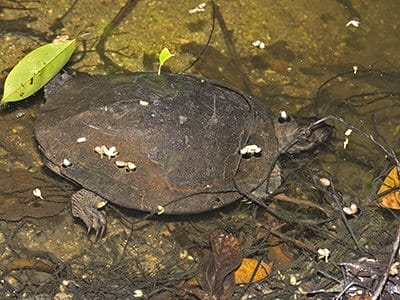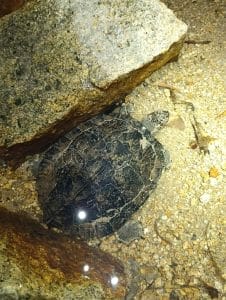Cyclemys enigmatica (Enigmatic Leaf Turtle)
Home > Turtle Database > Cyclemys enigmatica (Enigmatic Leaf Turtle)

Cyclemys enigmatica, also known as the enigmatic leaf turtle, is a lesser-known species of Asian turtle distinguished by its unique carapace markings and semi-aquatic nature. This species is native to Southeast Asia and is notable for its elusive behavior and limited research.
Native Turtle Species Map – Find Turtles by Region
Scientific Classification
- Kingdom: Animalia
- Phylum: Chordata
- Class: Reptilia
- Order: Testudines
- Family: Geoemydidae
- Genus: Cyclemys
- Species: Cyclemys enigmatica
Common Names
- Enigmatic Leaf Turtle
This Hilarious Turtle Book Might Know Your Pet Better Than You Do
Let’s be real—most turtle care guides feel like reading a textbook written by a sleep-deprived zookeeper.
This one’s not that.
Told from the snarky point of view of a grumpy, judgmental turtle, 21 Turtle Truths You’ll Never Read in a Care Guide is packed with sarcasm, sass, and surprisingly useful insights.
And hey—you don’t have to commit to the whole thing just yet.
Grab 2 free truths from the ebook and get a taste of what your turtle really thinks about your setup, your food choices, and that weird plastic palm tree.
It’s funny, it’s honest, and if you’ve ever owned a turtle who glares at you like you’re the problem—you’ll feel seen.
Identification
Description:
Cyclemys enigmatica has a moderately domed, elongated carapace with distinct, dark brown or black lines radiating from the center of each scute. The plastron is pale yellow with dark blotches, and the skin is typically olive or brown with yellowish markings on the head and limbs. Adults can reach up to 20 cm in carapace length.
Sexual Dimorphism:
Males are generally smaller than females and possess a longer, thicker tail. Females have a flatter plastron compared to the slightly concave plastron of males, aiding in reproduction.
Check more turtles from the Cyclemys genus
Native Origin and Distribution
Geographical Range:
This species is found in Southeast Asia, particularly in Thailand, Malaysia, and surrounding regions. Its precise distribution is not well-documented due to its cryptic nature.
Preferred Habitat
Cyclemys enigmatica prefers slow-moving freshwater environments, such as streams, rivers, and marshes. It is often found in densely vegetated areas near water bodies, where it can easily camouflage and retreat when threatened.
Behavior
Feeding Habits:
This turtle is omnivorous, feeding on a variety of aquatic vegetation, fruits, insects, and small invertebrates. It is primarily a nocturnal feeder, often foraging at dusk and dawn.
Predators:
Natural predators include larger reptiles, birds, and mammals. Human activities also pose significant threats, particularly through habitat destruction and capture for the pet trade.
Reproduction
Breeding Season:
The breeding season occurs during the warmer months, typically from April to July.
Reproductive Method:
Females lay clutches of 2-4 eggs in sandy or soft soil near water. The eggs incubate for about 90-120 days, depending on environmental conditions, before hatching.
Conservation
Extinction Status:
Cyclemys enigmatica is currently listed as “Data Deficient” by the IUCN due to a lack of comprehensive population studies. However, its numbers are suspected to be declining.
Threats:
Major threats include habitat loss due to deforestation and pollution, as well as illegal collection for the pet trade.
Conservation Measures:
Conservation efforts focus on habitat protection and reducing illegal trade. There is a need for further research to better understand the species’ status and implement targeted conservation strategies.
Economic Importance
This species has limited economic importance, primarily being of interest in the pet trade. However, its ecological role in maintaining healthy freshwater ecosystems is significant.
Interesting Facts
- Cyclemys enigmatica was only described as a distinct species relatively recently, in 2004.
- It is known for its elusive nature, making it difficult for researchers to study in the wild.
- The species’ name, “enigmatica,” reflects the mystery surrounding its behavior and ecology.

About Author
Muntaseer Rahman started keeping pet turtles back in 2013. He also owns the largest Turtle & Tortoise Facebook community in Bangladesh. These days he is mostly active on Facebook.














